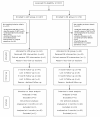Effectiveness of a 'Global Postural Reeducation' program for persistent low back pain: a non-randomized controlled trial
- PMID: 21162726
- PMCID: PMC3020172
- DOI: 10.1186/1471-2474-11-285
Effectiveness of a 'Global Postural Reeducation' program for persistent low back pain: a non-randomized controlled trial
Abstract
Background: The aim of this non-randomized controlled trial was to evaluate the effectiveness of a Global Postural Reeducation (GPR) program as compared to a Stabilization Exercise (SE) program in subjects with persistent low back pain (LBP) at short- and mid-term follow-up (ie. 3 and 6 months).
Methods: According to inclusion and exclusion criteria, 100 patients with a primary complaint of persistent LBP were enrolled in the study: 50 were allocated to the GPR group and 50 to the SE group. Primary outcome measures were Roland and Morris Disability Questionnaire (RMDQ) and Oswestry Disability Index (ODI). Secondary outcome measures were lumbar Visual Analogue Scale (VAS) and Fingertip-to-floor test (FFT). Data were collected at baseline and at 3/6 months by health care professionals unaware of the study. An intention to treat approach was used to analyze participants according to the group to which they were originally assigned.
Results: Of the 100 patients initially included in the study, 78 patients completed the study: 42 in the GPR group and 36 in the SE group. At baseline, the two groups did not differ significantly with respect to gender, age, BMI and outcome measures. Comparing the differences between groups at short- and mid-term follow-up, the GPR group revealed a significant reduction (from baseline) in all outcome measures with respect to the SE group.The ordered logistic regression model showed an increased likelihood of definitive improvement (reduction from baseline of at least 30% in RMDQ and VAS scores) for the GPR group compared to the SE group (OR 3.9, 95% CI 2.7 to 5.7).
Conclusions: Our findings suggest that a GPR intervention in subjects with persistent LBP induces a greater improvement on pain and disability as compared to a SE program. These results must be confirmed by further studies with higher methodological standards, including randomization, larger sample size, longer follow-up and subgrouping of the LBP subjects.
Trial registration: NCT00789204.
Figures





References
-
- Airaksinen O, Brox JI, Cedraschi C, Hildebrandt J, Klaber-Moffett J, Kovacs F, Mannion AF, Reis S, Staal JB, Ursin H, Zanoli G. COST B13 Working Group on Guidelines for Chronic Low Back Pain. Chapter 4. European guidelines for the management of chronic nonspecific low back pain. Eur Spine J. 2006;15(Suppl 2):S192–300. doi: 10.1007/s00586-006-1072-1. - DOI - PMC - PubMed
-
- Merskey H, Bogduk N. Classification of Chronic Pain: Descriptions of Chronic Pain Syndromes and Definition of Pain Terms. 2. Seattle: IASP Press; 1994.
Publication types
MeSH terms
Associated data
LinkOut - more resources
Full Text Sources
Other Literature Sources
Medical
Miscellaneous

